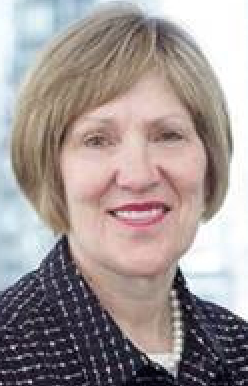It takes collaboration and commitment to advance diverse leadership in the profession.
CCBJ: Gloria, can you tell us about JPMorgan Chase’s Leading With Diversity law firm initiative and what it aims to achieve?
Gloria Mitka: We launched the Leading With Diversity initiative about a year and a half ago. The goal was to retain at least 50 percent diverse attorneys, which includes women, minorities and other diverse attorneys, in leadership positions on new litigation matters. The effort was spearheaded by our litigation group, but it’s since moved over to our transactional attorneys as well. We’ve had diverse attorneys working on our matters all along, of course, but as part of the initiative we stress the importance of having them in leadership roles.
McGuireWoods jumped in early to help JPMorgan Chase build this initiative. How did the firm’s involvement came about?
Nellie Hestin: McGuireWoods partner Mary Hackett was having drinks with JPMorgan Chase’s head of litigation, Jill Centella, a couple of years ago. It was on the heels of Judge Shira Scheindlin’s op-ed in The New York Times about how disproportionately few attorneys speaking in court are women. Women were in the courtroom, but they were not the ones actually standing up and arguing cases. Around the same time, the New York State Bar Association issued a study on the same topic. Mary and Jill got to talking about this issue and how to make a change to advance diverse lawyers at the highest levels of the profession. From that conversation, the idea was born to have a partnership between JPMorgan Chase and its outside firms to make this joint commitment, to really move the needle. Jill was incredibly motivated, and we were incredibly motivated, and the initiative took wings from there.
Gloria, tell us how McGuireWoods and other firms have helped this project to succeed.
Mitka: Partnering with outside firms like McGuireWoods has been instrumental to the success of the initiative. They’ve been co-sponsors with us on events where hundreds of diverse attorneys have come together to discuss our initiative and our commitment to improving diversity and inclusion. They’ve participated with us on an ongoing basis as we’ve had an opportunity to network and get to know their diverse attorneys better.
What real-world situations convinced JPMorgan Chase of the need to make sure that at least half of the leadership of the bank’s outside litigation teams, and its chosen arbitrators were either women or lawyers from diverse or other underrepresented groups?
Mitka: The lack of progress on diversity and inclusion in law firms has been well reported over the years. But the initiative was inspired in part by Judge Scheindlin. We had a case that was about to go to trial before her, and before the proceedings began, she asked for the women who would be speaking in court to stand up. That’s been a really important point for her. One lawyer that represented JPMorgan Chase stood up. None for our opponents. All of their attorneys were white men. We asked ourselves afterward if we had really done enough to move the needle on diversity. And the bottom line was that we didn’t think we had. Judge Scheindlin had written these articles asking the question, “If not now, when?” We kicked off our initiative to show that the time is now. We want our matters staffed with diverse attorneys in leadership roles. We want diverse teams – and that applies not just to the attorneys that are working on our matters, but to the mediators, experts and other vendors.
JPMorgan Chase has taken a bold step by incentivizing outside counsel teams led by women and diverse lawyers. Talk about the support clients can provide through initiatives like this for firms like McGuireWoods that are working to become more diverse and inclusive.
Hestin: I don’t think it comes as any surprise that clients like JPMorgan Chase have tremendous buying power that they can use to influence behavior. If they demand that a firm put forward diverse teams – and adjust their hiring decisions based on which law firms are responding to that demand – the firms are going to listen. In my view, this whole thing is symbiotic. JPMorgan Chase gets the diverse team and diverse lead lawyer that it wants. If firms are responding to that, they are getting the business that they want – and also, the diverse lawyer who ended up bringing in the business and leading the matter benefits from driving business generation.
From your own experience, can you each tell us how legal teams with strong women and diverse membership contribute to obtaining better outcomes for clients?
Hestin: There have been numerous studies that show that diverse teams achieve better results. Recent research has talked about how diverse teams are more likely to reexamine facts and assumptions. As a litigator, constantly reexamining facts and assumptions is going to help your case, as you work to put forward the best defense for the client. But it’s practical at a more basic level too. We live in a diverse country. We have a diverse judiciary, diverse juries, diverse opposing parties. In my experience, mirroring that diversity on a legal team allows us to react in a more nuanced way to what’s going on in the case – to pick up motivations that might be beneath the surface, or simple to be more creative in how we proceed.
Mitka: Building teams filled with diverse talent is a business imperative. It is well established that diverse teams bring more creative, more innovative solutions. They bring together different perspectives, different experiences, different backgrounds, different skills and interests. We strongly believe that diverse teams measurably impact the legal outcome. So we think that having diverse teams is not just the right thing to do, it’s the prudent thing to do.
What has McGuireWoods has been doing to elevate women and diverse lawyers into leadership position?
Hestin: I’d be remiss if I didn’t start by saying that McGuireWoods is the only firm in the AM Law 100 that has an African-American chairman. From my perspective, I’m seeing diversity at the highest levels of the firm, and that cascades down. Women and attorneys of color make up nearly half of our executive committee and more than half of our department chairs. And on a more personal level, as a woman, gender diversity in the partnership ranks is particularly important, and that is largely where the Leading With Diversity initiative began. We all know that law firms have a long way to go to achieve true parity at the partner level and especially at the equity partner level. But I see that commitment from McGuireWoods. The firm elevated me to partnership a year and a half after I lateraled, and for part of that time I was on maternity leave, but they made that investment in me.
Gloria, from the in-house counsel perspective, do you have any suggestions on how to make an initiative like this work?
Mitka: It’s important to make sure that the attorneys know that it’s a priority. They need to know what your expectations are, as well as the consequences. Because bottom line is that firms with diverse teams and diverse attorneys in leadership roles will get more work from us. As an in-house counsel, we’ve recognized that it goes both ways – that we need to challenge ourselves as well as our firms. So as part of our initiative, we’ve worked to deepen and explore new relationships with diverse attorneys and to take some risks, not just go back to the same attorneys we’ve always used in the past, but to really forge new relationships.
Published September 4, 2019.





